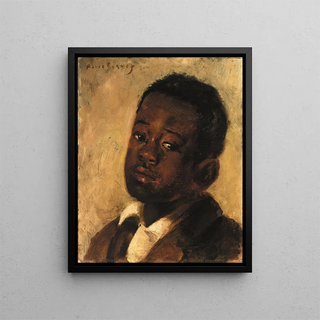Art print | Head of a Black boy - Alice Pike Barney Source: Reproduction | Tête d'un garçon noir - Alice Pike Barney


View from behind

Frame (optional)
In the vast panorama of art history, certain works stand out for their ability to capture the very essence of humanity. "Head of a Black Boy" by Alice Pike Barney is one of those creations that transcend the mere frame to invite deep reflection on identity, culture, and beauty. Created at the end of the 19th century, this piece serves as a poignant tribute to human diversity. Through the expressive gaze of the young boy, the artist manages to establish a timeless dialogue between the subject and the viewer, encouraging each to ponder the stories and emotions hidden behind this face.
Style and uniqueness of the work
The strength of "Head of a Black Boy" lies in Alice Pike Barney's unique style, which combines mastered technique with remarkable sensitivity. The chosen colors, the play of light and shadow, as well as the finesse of details, reveal an approach that is both realistic and poetic. The artist succeeds in infusing vibrant life into her subject, transforming a simple portrait into an exploration of the nuances of the human soul. The composition, centered on the boy's face, immediately draws the eye and allows for a full immersion into the expression of his emotions. This deliberate focus highlights the importance of each feature, each shadow, and each flash of light, creating a work that resonates deeply with the viewer.
The artist and her influence
Alice Pike Barney, an emblematic figure of American art, managed to establish herself in an artistic environment still largely dominated by patriarchal conventions. Her journey is marked by an incessant quest for authenticity and personal expression. As a painter, but also as a woman, she paved the way for many artists who followed in her footsteps. Her commitment to representing diversity and human complexity has had a lasting impact on 20th-century art and beyond. Through her works, Barney not only challenged the norms of her time but also contributed to enriching the dialogue around race and identity in art, making her a pioneer whose legacy endures.

Matte finish

View from behind

Frame (optional)
In the vast panorama of art history, certain works stand out for their ability to capture the very essence of humanity. "Head of a Black Boy" by Alice Pike Barney is one of those creations that transcend the mere frame to invite deep reflection on identity, culture, and beauty. Created at the end of the 19th century, this piece serves as a poignant tribute to human diversity. Through the expressive gaze of the young boy, the artist manages to establish a timeless dialogue between the subject and the viewer, encouraging each to ponder the stories and emotions hidden behind this face.
Style and uniqueness of the work
The strength of "Head of a Black Boy" lies in Alice Pike Barney's unique style, which combines mastered technique with remarkable sensitivity. The chosen colors, the play of light and shadow, as well as the finesse of details, reveal an approach that is both realistic and poetic. The artist succeeds in infusing vibrant life into her subject, transforming a simple portrait into an exploration of the nuances of the human soul. The composition, centered on the boy's face, immediately draws the eye and allows for a full immersion into the expression of his emotions. This deliberate focus highlights the importance of each feature, each shadow, and each flash of light, creating a work that resonates deeply with the viewer.
The artist and her influence
Alice Pike Barney, an emblematic figure of American art, managed to establish herself in an artistic environment still largely dominated by patriarchal conventions. Her journey is marked by an incessant quest for authenticity and personal expression. As a painter, but also as a woman, she paved the way for many artists who followed in her footsteps. Her commitment to representing diversity and human complexity has had a lasting impact on 20th-century art and beyond. Through her works, Barney not only challenged the norms of her time but also contributed to enriching the dialogue around race and identity in art, making her a pioneer whose legacy endures.






